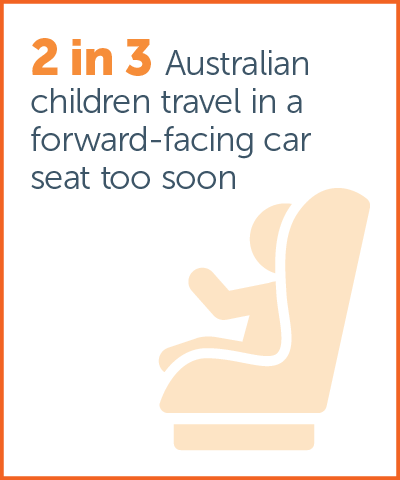Key findings
Many Australian children are not travelling in the safest restraint or position of the car, according to new findings from The Royal Children’s Hospital National Child Health Poll.
Two thirds of children (63%) aged seven to 10 years travel in an adult seatbelt without a booster seat, even though the majority of these children are below the recommended height to safely use an adult seatbelt.
Adult seatbelts are designed to safely restrain a person of at least 145 cm in height. Booster seats protect those children who are less than 145 cm tall, by lifting them up so that the seatbelt fits better across their shoulder, chest and hips. Extending booster seat use by older children until they reach a height of at least 145 cm may be a way of reducing child death and disability from road traffic crashes.
Almost half of children (47%) aged between seven and 12 years travel in the front seat of the car, doubling their risk of being injured in a crash.
Children between six months and two years of age are being put at risk too, with more than half (53%) of polled parents turning their children to travel forward-facing earlier than recommended.
The nation-wide poll also found:
- The most common age for first travelling without a booster seat is seven years (35%) followed by eight years (28%)
- The leading reason for having children under 12 travel in the front seat is that their parents believed they were old enough to safely do so (39%)
Parents who transitioned their children (aged seven to 12) out of booster seats into an adult seatbelt said:
- By law they were old enough to sit without a booster seat (42%)
- Their child was tall enough to safely sit without a booster seat (42%).
- Their child was too grown up for a booster seat (17%)
- Their child did not want to sit in a booster seat (14%)
Most parents (71%) indicated they did not know how tall a child should be to safely use an adult seatbelt and among the 29% who reported knowing, only 11% got it right – meaning fewer than 3% of parents know that children should be at least 145 cm tall to safely travel in an adult seatbelt without a booster seat.
Only one in 10 (11%) children were 10 years or older when first travelling in the family car without a booster seat, suggesting the vast majority are transitioning out of the booster seat much earlier than recommended as safest practice.
RCH National Child Health Poll Director Dr Anthea Rhodes said “Children aged seven to 12 years old are being left vulnerable to life-threatening injuries from car crashes due to inadequate use of car restraints and travelling in the front seat of the car.”
Tips for parents
- To keep your young child entertained rearward-facing, utilize toys and mirrors while driving
- Before transitioning your child out a booster seat ensure they are taller than 145 cm and can pass the five-step test (see on the For Parents page). Place a marker on a wall in your home and measure your child
- If your child thinks they are too grown up for a booster seat, talk to them about why it’s important they remain in one until they reach 145 cm tall
- Encourage your child to sit in the back seat of the car until they reach the age of 13 and explain that they are safest in the back
- RCH car seat safety – Height measure
For more tips and resources please visit our For Parents page.



Poll report


Poll questions

Poll questions
Download poll questions
In the news

Information for parents
Tips for parents
- To keep your young child entertained rearward-facing, utilize toys and mirrors while driving
- Before transitioning your child out of a booster seat ensure they are taller than 145 cm and can pass the five-step test (see below). Place a marker on a wall in your home and measure your child
- If your child thinks they are too grown up for a booster seat, talk to them about why it’s important they remain in one until they reach 145 cm tall
- Encourage your child to sit in the back seat of the car until they reach the age of 13 and explain that they are safest in the back
The five-step test
Once a child reaches 145 cm tall you can use the five-step test to see that they are big enough to use an adult seatbelt. You can check this by seeing if they can do the following:
- Sit with their backs firmly against the seat back
- Bend their knees comfortably over the front of the seat cushion
- Sit the sash belt across their mid-shoulder
- Sit with the lap belt across the top of their thighs
- Stay in this position for the whole car trip
Car seat safety resources
- Vicroads: Child restraints
- RACV: Child restraints
- Child car seats: Find a child car seat (includes a list of booster seats suitable for children aged seven years and older)
- Child car seats: When can I move my child to the next car seat?
- Kidsafe: Restraint guidelines
- Raising children network: Child restraints and booster seats
- Better health: Child safety in the car
- Car seats save lives: Child restraints and booster seats, what you need to know
The Royal Children’s Hospital resources
- RCH Kids Health Info – Child car seats
- RCH car seat safety – Height measure




[…] [1] https://rchpoll.org.au/polls/car-seat-safety-are-australian-children-safe/ […]